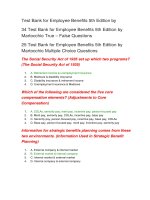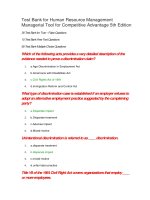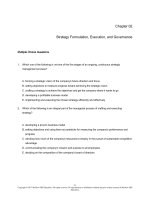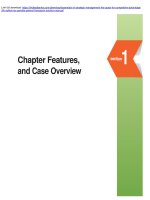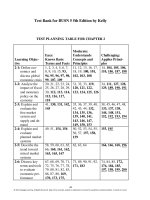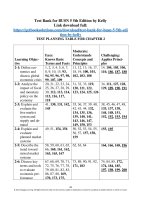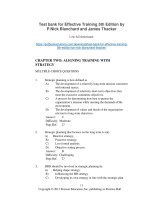100 test bank for human resource management managerial tool for competitive advantage 5th edition
Bạn đang xem bản rút gọn của tài liệu. Xem và tải ngay bản đầy đủ của tài liệu tại đây (131.62 KB, 25 trang )
Test Bank for Human Resource Management
Managerial Tool for Competitive Advantage 5th Edition
30 Test Bank for True – False Questions
10 Test Bank Free Text Questions
60 Test Bank Multiple Choice Questions
Which of the following acts provides a very detailed description of the
evidence needed to prove a discrimination claim?
1.
a.Age Discrimination in Employment Act
2.
b.Americans with Disabilities Act
3.
c.Civil Rights Act of 1991
4.
d.Immigration Reform and Control Act
What type of discrimination case is established if an employer refuses to
adopt an alternative employment practice suggested by the complaining
party?
1.
a.Disparate impact
2.
b.Disparate treatment
3.
c.Adverse impact
4.
d.Mixed-motive
Unintentional discrimination is referred to as ____ discrimination.
1.
a.disparate treatment
2.
b.disparate impact
3.
c.mixed-motive
4.
d.unfair labor practice
Title VII of the 1964 Civil Right Act covers organizations that employ ____
or more employees.
1.
a.20
2.
b.5
3.
c.10
4.
d.15
A case of prima facie discrimination is established if the hiring rate of a
disadvantaged group is less than ____ of the advantaged group.
1.
a.half
2.
b.three-fourths
3.
c.four-fifths
4.
d.one-third
All the following are true about mixed-motive cases EXCEPT:
1.
a.The employment decision, such as hiring or promotion, is based partly on a
“legitimate” motive.
2.
b.The employment decision is partly based on a discriminatory motive.
3.
c.The CRA of 1991 states that mixed-motive decisions are lawful.
4.
d.It is a form of employment discrimination.
In which of the following cases may an employer not use a business
necessity defense?
1.
a.Disparate impact
2.
b.Disparate treatment
3.
c.Adverse impact
4.
d.Mixed-motive
The Immigration Reform and Control Act (IRCA) of 1986 prohibits
discrimination on the basis of:
1.
a.color and national origin.
2.
b.color and citizenship.
3.
c.citizenship and national origin.
4.
d.national origin and religion.
A supervisor that denies a female employee promotion to a high-pressure
job because he feels that women do not work well under pressures is an
example of a potential ____ case.
1.
a.disparate treatment
2.
b.disparate impact
3.
c.affirmative action
4.
d.unfair labor practice
What type of case is established if an employee presents evidence that
makes the employer’s actions appear discriminatory?
1.
a.Mixed-motive
2.
b.Unintentional discrimination
3.
c.Disparate impact
4.
d.Prima facie
The main provisions of the 1991 amendments to the Civil Rights Act of
1964 included all but which of the following?
1.
2.
a.Compensatory damages
b.Caps on damages based on the number of employees employed by the
employer
3.
c.Jury trial if either party demands one
4.
d.Punitive damages in disparate impact cases
Under the 1991 amendments to the 1964 Civil Rights Act, an employer
may be liable for ____ if the discriminatory practices were engaged in with
malice or reckless indifference.
1.
a.limited punitive damages
2.
b.unlimited punitive damages
3.
c.fines and imprisonment
4.
d.limited back pay and legal fees
What type of discrimination occurs if an arbitrary selection practice
resulted in the selection of a disproportionately low number of people
belonging to a particular protected group?
1.
a.Disparate treatment
2.
b.Disparate impact
3.
c.Mixed-motive
4.
d.Intentional discrimination
Subcategories of people within each protected classification are referred
to as:
1.
a.protected categories.
2.
b.protected divisions.
3.
c.protected groups.
4.
d.protected sects.
Categories based on race, color, sex, religion, national origin, age, and
disability that are protected from discrimination by EEO laws are called:
1.
a.preserved groups.
2.
b.protected classifications.
3.
c.reserved categories.
4.
d.protected categories.
Which process is used to determine whether between-group differences in
hiring rates are large enough to be important in a disparate impact case?
1.
a.McDonnell-Douglas test
2.
b.Four-fifths rule
3.
c.Utilization analysis
4.
d.Quota analysis
Intentional discrimination is referred to as ____ discrimination.
1.
a.disparate treatment
2.
b.disparate impact
3.
c.mixed-motive
4.
d.unfair labor practice
Protected classifications included under federal anti-discrimination laws
include all but which of the following?
1.
a.Race
2.
b.Groupism
3.
c.Age
4.
d.Religion
The 1991 amendments to the Civil Rights Act of 1964 made it unlawful for
employers:
1.
a.to show job relatedness.
2.
b.to use different cut-off scores for employment-related tests on the basis of race.
3.
c.to demonstrate business necessity.
4.
d.to demonstrate that it would have taken the same action in the absence of an
impermissible motivating factor.
A prima facie case of disparate treatment may be established in all but
which of the following ways?
1.
a.Show a restricted company policy
2.
b.Show that discriminatory remarks were being used
3.
c.The McDonnell-Douglas test
4.
d.The four-fifths rule
Title VII of the 1964 Civil Rights Act prohibits discrimination in
employment for all but which of the following bases?
1.
a.Race
2.
b.Sex
3.
c.Age
4.
d.Religion
Which of the following acts entitles the victim to relief in the form of legal
costs and back pay if a court determines that discrimination has
occurred?
1.
a.Civil Rights Act (Title VII)
2.
b.Age Discrimination in Employment Act
3.
c.Immigration Reform and Control Act
4.
d.Americans with Disabilities Act
An employee of an employer covered by the ADA must be offered a(n)
____ if they can otherwise perform the essential functions of the job.
1.
a.reasonable accommodation
2.
b.different job
3.
c.paid leave policy
4.
d.undue hardship job
Which of the following is not included in the Civil Rights Act of 1991?
1.
a.Provision to provide appropriate remedies for intentional discrimination in the
workplace.
2.
b.Provision to provide appropriate remedies for unlawful harassment in the
workplace.
3.
c.Provision to provide statutory guidelines for the adjudication of disparate impact
suits.
4.
d.Provision to reduce the scope of relevant civil rights statutes in cases of
discrimination.
The McDonnell-Douglas test requires that plaintiffs show all but which of
the following to establish a prima facie case of discriminatory treatment?
1.
a.Individual belongs to the protected group in question.
2.
b.Adoption of an arbitrary selection practice.
3.
c.Individual was rejected even though qualified for a specific job that he/she
applied for.
4.
d.After rejection, the position was filled by someone who was not a member of that
protected group.
The 1991 amendments to the 1964 Civil Rights Act expose employers to
the possibility of being liable for all but which of the following?
1.
a.Fines and imprisonment
2.
b.Punitive damages
3.
c.Compensatory damages
4.
d.Legal fees and back pay
In addition to being an anti-discrimination statute, IRCA requires
employers to:
1.
a.obtain proof that the person offered the job is not an illegal alien.
2.
b.develop an affirmative action plan.
3.
c.conduct utilization analysis.
4.
d.use different cut-off scores on employment-related tests on the basis of national
origin.
The type of discrimination case in which an employment decision is based
partially on a “legitimate” motive and partially on a discriminatory one is
known as a(n):
1.
a.prima facie case.
2.
b.adverse impact case.
3.
c.mixed-motive case.
4.
d.disparate impact case.
The ADA defines ____ as those accommodations that require significant
difficulty to implement or significant expense on the part of the employer.
1.
a.flextime
2.
b.disparate impact
3.
c.undue hardship
4.
d.affirmative action
In cases of intentional discrimination, the total damages shall not exceed
____ for firms employing 201–500 employees.
1.
a.$50,000
2.
b.$100,000
3.
c.$200,000
4.
d.$300,000
60 Free Test Bank for Human Resource Management
Managerial Tool for Competitive Advantage 5th Edition
Lawrence Kleiman Multiple Choice Questions - Page 2
Firms using the practice of ____ consider only members from
underutilized groups when filling a particular position.
1.
a.differential standards
2.
b.one-for-one hiring
3.
c.minority positions
4.
d.extra consideration in hiring
Research has identified all but which of the following as a trigger of
corporate downsizing?
1.
a.Decreased demand for the firm’s products
2.
b.Technological advances
3.
c.Corporate culture
4.
d.Organizational restructuring
Which of the following forms of preferential treatment is illegal if it
violates the provisions of a collective bargaining agreement?
1.
a.Minority positions
2.
b.Differential standards
3.
c.Preferential layoffs
4.
d.Extra consideration in hiring
Under which of the following conditions is preferential treatment
considered illegal?
1.
a.The applicant hired must meet the minimum qualifications for the job.
2.
b.The AAP must be temporary in nature.
3.
c.The numerical hiring goals must be reasonable.
4.
d.The protected group status must be the only factor considered in the hiring
decision.
Employment criteria must directly relate to a prospective employee’s
ability to perform the job effectively to be justified as a:
1.
a.business necessity.
2.
b.reasonable accommodation.
3.
c.prima facie case.
4.
d.mixed-motive case.
Which of the following tasks would a management find difficult to carry
out in a post-layoff scenario?
1.
a.Retrain employees
2.
b.Reestablish motivation
3.
c.Redeploy employees
4.
d.Retain competencies
____ is defined as treating people unfairly based on their membership in a
protected group.
1.
a.Disparate treatment
2.
b.Disparate impact
3.
c.Affirmative action
4.
d.Remedial action
In which nontraditional work arrangement does success depend on
employee self-discipline because of lack of supervision?
1.
a.Flextime
2.
b.Telecommuting
3.
c.Job sharing
4.
d.Outsourcing
Which of the following should be carried out before developing a remedial
plan during affirmative action implementation?
1.
a.Remedial analysis
2.
b.Utilization analysis
3.
c.Strategic analysis
4.
d.Quota analysis
The U.S. Supreme Court has ruled that preferential treatment is legal if
engaged in as part of a bona fide affirmative action plan that confirms to
all of the following EXCEPT:
1.
a.it is designed to remedy underutilization.
2.
b.it is flexible in nature.
3.
c.it is on a permanent basis.
4.
d.it is reasonable in nature.
Which of the following forms of preferential treatment is forbidden by the
CRA of 1991 and is thus illegal?
1.
a.Preferential layoffs
2.
b.One-for-one hiring
3.
c.Extra consideration in hiring
4.
d.Differential standards
Which of the following is not a recommended step for creating a diversityfriendly workplace?
1.
a.Make diversity a corporate goal.
2.
b.Single out employees of a particular race or ethnicity to handle diversity issues.
3.
c.Start a mentoring program that pairs employees of diverse backgrounds.
4.
d.Establish an internal procedure for employees to report incidents of harassment
or discrimination.
Which form of preferential treatment is practiced when a firm increases
minority representation by hiring one minority for each nonminority
hired?
1.
a.One-for-one hiring
2.
b.Extra consideration in hiring
3.
c.Minority positions
4.
d.Differential standards
Which of the following is not an element of an affirmative action plan?
1.
a.Goal
2.
b.Action step
3.
c.Appraisal
4.
d.Timetable
All but which of the following might be an alternative to employee layoffs?
1.
a.Job sharing
2.
b.Restricting overtime
3.
c.Using a longer workweek
4.
d.Implementing early retirement programs
A(n) ____ is a written statement that specifies how the organization plans
to increase the utilization of targeted groups.
1.
a.reasonable accommodation plan
2.
b.remedial action plan
3.
c.affirmative action plan
4.
d.utilization plan
Which of the following forms of preferential treatment is used to remedy a
severe case of underutilization?
1.
a.One-for-one hiring
2.
b.Extra consideration in hiring
3.
c.Recruitment efforts
4.
d.Preferential layoffs
Which of the following forms of preferential treatment give hiring
preference to members of underutilized groups?
1.
a.Minority positions
2.
b.One-for-one hiring
3.
c.Differential standards
4.
d.Extra consideration in hiring
____ is a nontraditional work-at-home arrangement in which employees
typically have an office set up in their home similar to that at the office.
1.
a.Flextime
2.
b.Downtime
3.
c.Telecommuting
4.
d.Hometime
____ is defined as any practice without business justification that has
unequal consequences for people of different groups.
1.
a.Disparate impact
2.
b.Disparate treatment
3.
c.Affirmative action
4.
d.Remedial action
An affirmative action plan ____ specifies the percentage of protected
group representation it seeks to reach.
1.
a.goal
2.
b.timetable
3.
c.strategy
4.
d.reach
____ is a statistical procedure that compares the percentage of each
protected group for each job category within the organization to that in
the available labor market.
1.
a.Utilization analysis
2.
b.Remedial analysis
3.
c.Quota analysis
4.
d.Affirmative analysis
All the following are true about an affirmative action plan EXCEPT:
1.
a.It aim to redress past discrimination against protected classes.
2.
b.It attempts to accomplish its aims through initiatives that are “color-blind.”
3.
c.It aims to correct racial and gender imbalances in the workforce.
4.
d.The overall aim of affirmative action is identical to that of EEO.
To defend itself against a violation of the four-fifths rule, a firm must
demonstrate that the procedure in question is a(n):
1.
a.business necessity.
2.
b.reasonable accommodation.
3.
c.authentic characteristic.
4.
d.traditional characteristic.
____ occurs when the structure of a firm is modified to become less
hierarchical by cutting out the layer of middle management.
1.
a.Organizational restructuring
2.
b.Organizational upsizing
3.
c.Organizational enrichment
4.
d.Organizational enlargement
Which nontraditional work arrangement allows employees the flexibility of
working alternate months or seasons?
1.
a.Flextime
2.
b.Telecommuting
3.
c.Job sharing
4.
d.Outsourcing
A consequence of mergers and takeovers is increased ____ because of
employees seeking to protect their own jobs at the expense of others.
1.
a.organizational commitment
2.
b.organizational conflict
3.
c.voluntary turnover
4.
d.organizational restructuring
A ____ case of sex discrimination can be established if the court
determines that an employer’s hiring rate for women workforce is less
than four-fifths of the hiring rate for men.
1.
a.disparate impact
2.
b.disparate treatment
3.
c.prima facie
4.
d.mixed-motive
The practice of giving members of underutilized groups some advantage
over others in the employment process is called:
1.
a.remedial action.
2.
b.affirmative action.
3.
c.preferential treatment.
4.
d.intentional discrimination.
Which of the following is not an example of an action step in an
affirmative action implementation?
1.
2.
a.Meet with protected group employees to request suggestions.
b.Review current selection and promotion procedures to determine job
relatedness.
3.
c.Design and implement a career counseling program for lower-level employees.
4.
d.Install a more subjective performance appraisal system.
0 Free Test Bank for Human Resource Management
Managerial Tool for Competitive Advantage 5th Edition
Lawrence Kleiman True - False Questions
Once a plaintiff establishes a prima facie case, the court will automatically
find the employer guilty.
1.
True
2.
False
Under the Pregnancy Discrimination Act of 1978, employees who are
unable to perform their jobs because of a pregnancy-related condition
must be treated in the same manner as employees who are temporarily
disabled for other reasons.
1.
True
2.
False
The Age Discrimination in Employment Act includes protection for
workers under 40 years of age.
1.
True
2.
False
There is little that organizations can do to help older workers compensate
for their diminishing skills.
1.
True
2.
False
When a plaintiff establishes a prima facie case, it means that the
complainant has been able to establish the merits of the case sufficiently
enough for the courts to agree to look into the matter further.
1.
True
2.
False
To manage diversity effectively, an organization must be sensitive to the
needs of new workers.
1.
True
2.
False
Under the Americans with Disabilities Act, an employer cannot require an
employee to demonstrate that they can perform the essential functions
with or without a reasonable accommodation.
1.
True
2.
False
A utilization analysis is a statistical procedure that compares the
percentage of each protected group for each job category within the
organization to that of the available labor market.
1.
True
2.
False
The 1991 amendments to the 1964 Civil Rights Act extended the rights of
claimants to receive punitive damages.
1.
True
2.
False
Title VII of the 1964 Civil Rights Act covers organizations that employ 15
or more workers for at least 20 weeks during the year.
1.
True
2.
False
An employer may not discriminate against a 57-year-old by giving
preference to a 45-year-old.
1.
True
2.
False
Telecommuting is a nontraditional work-at-home arrangement in which
employees have an office set up in their home similar to that at the office.
1.
True
2.
False
Affirmative action programs must be designed to correct for past
employer discrimination or, in some cases, correct for past disparate
impact.
1.
True
2.
False
The workplace has been experiencing a dramatic decrease in the number
of dual-income families in recent years.
1.
True
2.
False
Diversity training is designed to make employees aware of their biases or
stereotyped views regarding various minority groups and then convince
them to change their views.
1.
True
2.
False
In defending itself against a violation of the four-fifths rule, an employer is
not required to demonstrate that the procedure in question is a business
necessity.
1.
True
2.
False
EEO initiatives are “color conscious” whereas affirmative action initiatives
are “color blind.”
1.
True
2.
False
If a plaintiff can prove that a company has a policy that restricts the
selection of an entire protected group, he or she automatically establishes
a prima facie case of disparate treatment discrimination.
1.
True
2.
False
A disparate impact case of discrimination may be established if a
company uses an employment practice that causes a disparate impact
and cannot demonstrate that the challenged practice is job-related and
consistent with business necessity.
1.
True
2.
False
An important factor accounting for a great deal of downsizing can be
traced to advances in technology.
1.
True
2.
False
The 1991 amendments to Title VII reduced the impact of EEO regulations
on employers.
1.
True
2.
False
Plaintiffs in disparate impact cases are required to use the McDonnellDouglas test to establish a prima facie case of discrimination.
1.
True
2.
False
Younger managers generally do not feel uncomfortable directing the work
of people who are old enough to be their parents and grandparents.
1.
True
2.
False
Under the 1991 amendments to Title VII, employers are permitted to use
different cut-off scores on the basis of race on employment tests.
1.
True
2.
False
An invisible barrier in many organizations that has hindered the
advancement of women and minorities is called the glass ceiling.
1.
True
2.
False
Disparate impact discrimination is defined as any practice without
business justification that has unequal consequences for people of
different protected groups.
1.
True
2.
False
Organizational restructuring generally involves a firm cutting out a layer
of middle management to become less hierarchical.
1.
True
2.
False
Under the disparate treatment theory of discrimination, the plaintiff is not
required to prove that the employer intentionally discriminated against
them.
1.
True
2.
False
When utilizing a BFOQ defense, the employer is admitting to intentionally
discriminating against all members of a protected group.
1.
True
2.
False
EEO laws designed to eradicate employment discrimination based on
race, sex, religion, national origin, age, and disability are categorized as
protected classifications.
1.
True
2.
False
10 Free Test Bank for Human Resource Management
Managerial Tool for Competitive Advantage 5th Edition
Lawrence Kleiman Free Text Questions
Describe the factors that triggered the recent trend toward downsizing.
Answer Given
The recent trend toward downsizing has been triggered by three factors: (1) many
organizations have found it necessary to cut the size of their workforce due to a
decline or crisis in the firm; (2) the advent of technological advances, which has
enabled many companies to produce more with fewer people; and, (3)
organizational restructuring, in which the structure of a firm is modified to become
less hierarchical by cutting out the “layer” of middle management.
Describe the basic differences between disparate treatment and disparate
impact discrimination.
Answer Given
Disparate treatment is intentional discrimination and involves treating people
unfairly based on their membership in a protected group. It is often the result of an
employer’s bias or prejudice toward a particular group. A plaintiff must prove that
the decision was intentional. Plaintiffs may be awarded punitive and compensatory
damages in addition to legal fees and costs. Disparate impact is unintentional
discrimination and is defined as any practice without business justification that has
unequal consequences for people of different protected groups. Plaintiffs do not
have to prove intent on the part of the employer to discriminate and victims are not
entitled to punitive damages.
Describe the basic components of an affirmative action plan.
Answer Given
Affirmative action plans are designed to remedy past and current discrimination.
Affirmative action initiatives are color-conscious in nature and involve making
special provisions to recruit, train, retain, promote, or grant some other benefit to
members of protected groups. Government contractors are required to have
affirmative action plans in order to secure contracts and some employers who
have been guilty of blatant discrimination are also required to implement plans to
rectify the effects of past discrimination. Affirmative action plans consists of two
primary steps: utilization analysis to identify the underutilized protected groups
within various job categories and then developing a remedial plan that targets
these underutilized groups.
Describe how an organization can create a diversity-friendly workplace.
Answer Given
A firm can create a diversity-friendly workplace by taking the following steps:
making diversity a corporate goal, holding talks centered around cultural diversity
issues, providing employees with opportunities to attend local cultural events and
exhibits, and avoiding singling out employees of a particular race or ethnicity to
handle diversity issues. Employers can also start mentoring programs that pair
employees of diverse backgrounds and foster an open, friendly work environment.
Establishing an internal procedure for employees to report incidents of
harassment or discrimination is also useful.
When is the BFOQ defense used? What are the employer's arguments in
this defense?
Answer Given
When the employer has a policy that excludes an entire protected group, its only
viable option is the use of a BFOQ defense. The term BFOQ refers to “bona fide
occupational qualification.” When using a BFOQ defense, the employer argues
that it purposely discriminated against all members of a protected group for one of
the following four reasons: (1) All or nearly all: All or nearly all of the members of
that group are incapable of performing the job in question. (2) Authenticity: To be
“authentic,” the employer must limit its hiring to members of a particular protected
group, thus excluding all others. (3) Propriety: It would be improper to hire
members of one or the other sex for a particular job. (4) Safety: The employment
of an older worker would put the worker or others at risk.
Describe the conditions under which preferential treatment for members
of protected groups in affirmative action plans may be legal.
Answer Given
Conditions under which preferential treatment is legal include: the AAP must serve
a remedial purpose, the goals and timetables targeted by the AAP must not be
achievable by using measures which are less extreme than preferential treatment,
one’s protected group status must not be the only factor considered in the hiring
decision, the AAP must be temporary in nature, the numerical hiring goals must be
reasonable, the AAP must not unjustly burden the rights of nonminorities, and the
applicant hired must meet the minimum qualifications for the job.
Discuss the major provisions of the Americans with Disabilities Act of
1990.
Answer Given
The Americans with Disabilities Act (ADA) of 1990 “provides a clear and
comprehensive national mandate for the elimination of discrimination against
individuals with disabilities.” The employment implications of the act, which are
delineated in Titles I (private section) and II (public sector) of the ADA, affect
nearly all organizations employing 15 or more workers. According to the act, an
individual is considered disabled if he or she has a physical or mental impairment
that substantially limits one or more of the individual’s major life activities, such as
walking, seeing, hearing, breathing, and learning, as well as the ability to secure
or retain employment.
Summarize the major (equal employment opportunity) EEO laws.
Answer Given
The major EEO laws differ from one another primarily in terms of the specific
protected classifications covered. (1) 1964—Civil Rights Act (Title VII): Prohibits
employment discrimination on the basis of race, color, religion, sex, and national
origin. It covers most employers of 15 or more employees. (2) 1967—Age
Discrimination in Employment Act: Prohibits discrimination based on age. (3) 1978
—Pregnancy Discrimination Act: Prohibits discrimination because of a woman’s
pregnancy-related condition. (4) 1986—Immigration Reform and Control Act:
Prohibits employers from knowingly hiring aliens who are not authorized to work in
the United States. (5) 1990—Americans with Disabilities Act: Prohibits
discrimination based on an employee’s disability. (6) 1991—Civil Rights Act of
1991: Extends the rights of claimants to receive punitive damages. (7) 2008—
Genetic Information Nondiscrimination Act: Prohibits employers from
discriminating against applicants or employees on the basis of genetic information
gleaned from the individual or family members.
Explain the McDonnell-Douglas test and the four-fifths rule.
Answer Given
McDonnell-Douglas test: The Supreme Court has developed a test that is used to
infer the presence of discriminatory intent when more direct evidence of
discrimination is lacking. It requires the plaintiff to show that he/she: (1) belongs to
the protected group in question, (2) has applied for and is qualified for the job for
which the employer was seeking applicants; (3) was rejected; (4) after rejection,
the position remained open or was filled by someone who was not a member of
that protected group. The four-fifths rule: The four-fifths rule helps the courts
determine whether between-group differences in hiring rates are large enough to
be important. It is calculated by comparing the hiring rate of the “disadvantaged”
protected group (i.e., the group claiming discrimination) with the rate of the
“advantaged” group. A prima facie case of discrimination is established when the
hiring rate of the former group is less than four-fifths of the latter group.
Describe the major provisions of the 1964 Civil Rights Act as amended.
Answer Given
Title VII applies to employers with 15 or more employees. The law makes it
unlawful for employers to discriminate on the basis of race, color, religion, national
origin, and sex. The act is enforced by the Equal Employment Opportunity law.
Remedies for violation of the law include punitive and compensatory damages,
back-pay, and legal costs.


